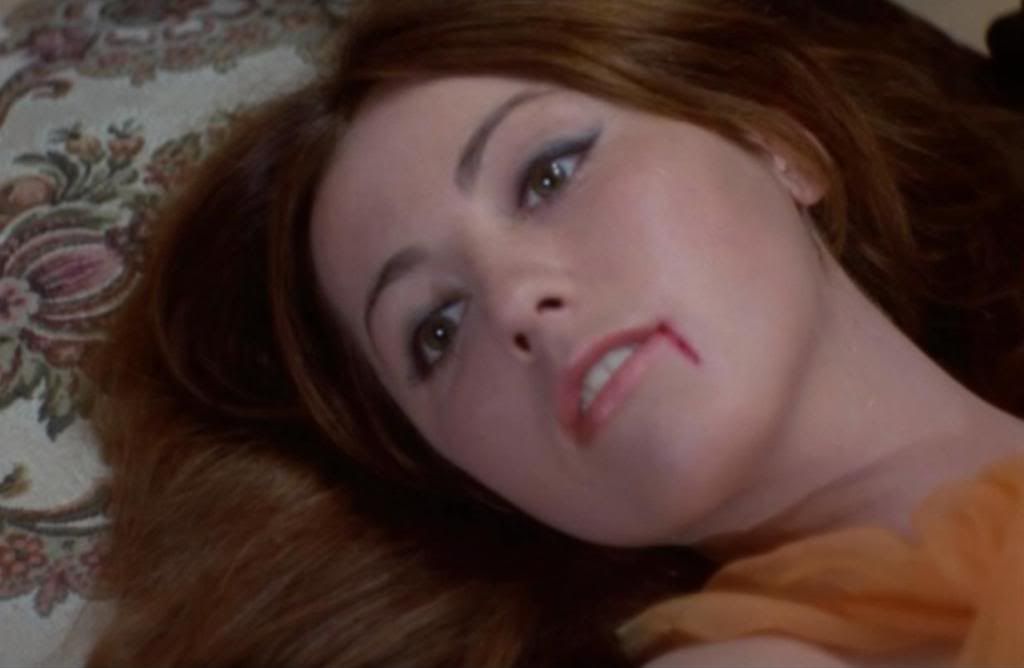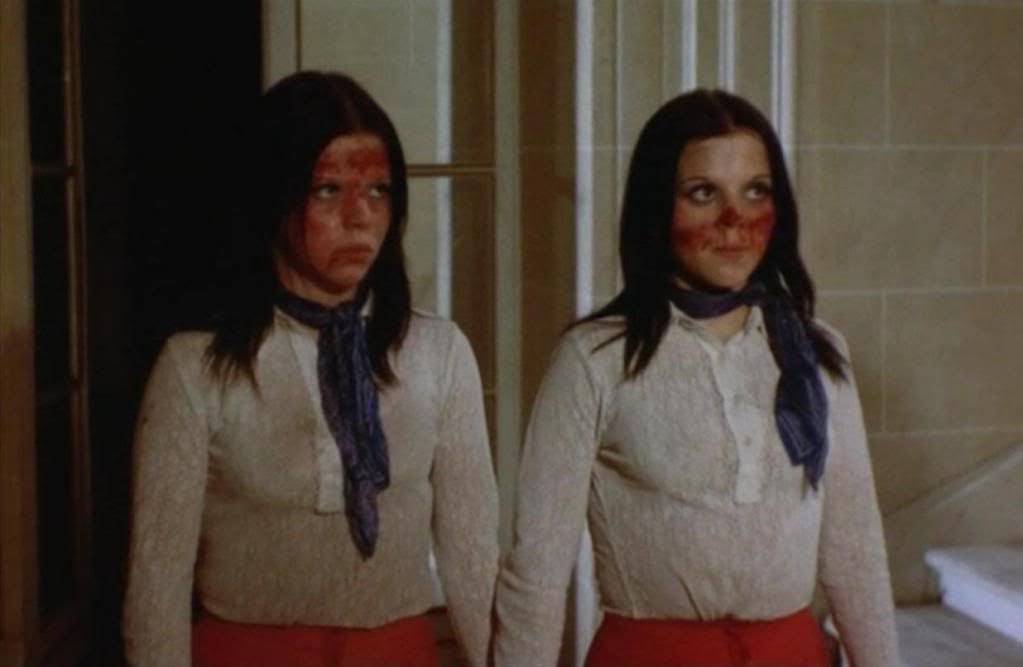

One pretty much knows what one is in for with a film titled The Nude Vampire, and Jean Rollin's second feature (his first in color) certainly delivers on the promise of stiff acting, absurd plotting, and blatantly exploitative sequences that offer little besides titillation. What's notable about this film, though, is that it's also sensuous, moody, chilling, and strangely poetic, a trashy B-movie with copious nudity that intermittently becomes something much stranger and more mysterious. It's a very visual film, its dialogue sparse, and what little there is of it mostly silly and inconsequential. It's the images that matter, images of a surreal, unsettling strangeness — unsettling because Rollin's aesthetic is so matter-of-fact, making the supernatural and the bizarre seem utterly quotidian.
The film's visual emphasis is confirmed right from its extraordinary opening sequence, in which it takes nearly ten minutes for anyone to say a word. Instead, Rollin simply delivers one mysterious, outrageous set piece after another. Cult scientists in red hoods strip a girl wearing a similar hood and inject her with color-coded chemicals that drip into beakers around the lab. The bright chemicals look like dyes prepared for Easter eggs more than scientific solutions, but no matter. The pacing is slow, almost narcotized, and Rollin cuts between steady, silent closeups: the red-hooded men, their eyes peering out through thin, ragged slits in their cloth hoods, the beakers and scientific equipment around the room, the girl's eyes peering out from behind her own hood. In the next scene, a girl (Caroline Cartier) in a gauzy orange dress, naked beneath the thin, translucent material, runs through the darkness, pursued by men in animal masks. This sequence is evocative and beautiful and creepy, the girl and her pursuers casting elongated shadows on the blank walls of the buildings, Rollin making excellent use of wide expanses of negative space with the girl trapped between these monstrous shadow-creatures. The deliberate pacing only adds to the creepiness of it all, with Rollin frequently cutting in inscrutable closeups of the men in their gaudy, sinister masks.
The girl is soon cornered by these masked men and shot, and the scene is witnessed by Pierre (Rollin's half-brother Olivier), who escapes and follows the masked men back to a mansion, which he decides to investigate. His inquiry leads him — in a sequence that prefigures Stanley Kubrick's Eyes Wide Shut — to a suicide cult that seems to be connected to his father Georges (Maurice Lemaître). The plot never even remotely makes any sense, but it doesn't really need to: Pierre just wanders around, stumbling into trouble, witnessing what seems to be a war between his father and some mysterious supernatural beings, who are struggling over control of the girl in orange, who's not dead, it turns out, because she's supposedly a vampire. There are countless absurdities along the way, like the fact that when Pierre calls his painter friend Robert (Pascal Fardoulis) for help, Robert first dresses up in a tuxedo before going to get his friend.


It's a nutty, outlandish movie, and a very trashy one. The action periodically comes to a halt for Rollin to deliver scenes of blatant titillation that are as woodenly staged as everything else in the film, which renders them almost as unsettling as the horror set pieces. At one point, there's an extended sequence in which a naked girl models for Robert, caressing her breasts with fingers capped with long golden nails, and it just goes on and on and on, punctuated with periodic cutaways to Robert's leering face in an uncomfortably tight closeup that accentuates his exaggeratedly pervy expression. Rollin has the instincts of a pornographer mixed with the sensibility of a visual poet — certainly not a verbal poet, though — and he often stages scenes from odd angles that seem intended primarily to provide a voyeuristic glance up a girl's dress.
But these obvious softcore flourishes are really the most boring aspect of the film, so obviously catering to simple titillation that the images fail to be even remotely exciting, in any sense. Rollin's eroticism is more memorably embodied in the pair of twins (Cathy and Marie-Pierre Castel) who serve as Georges' servants and seem to exist primarily to dress up in a succession of outrageous sci-fi fetishism costumes. In one scene, as Georges talks on the telephone, he idly plays with the girls' clunky, bizarre costumes, seemingly as a substitute for the bored doodling that most people do while on the phone. The twins are eerie and strange, like almost everything in this movie, and later they become perfectly synchronized, hand-holding avenging spirits, their faces smeared with blood as they relentlessly pursue their victim through a graveyard.
The film is rough and uneven and obviously has no budget — not even for effects; when one woman holds a pistol to her head and shoot herself, it's totally bloodless — but Rollin turns this necessary minimalism into an asset. It's a very stark film, set in dark, empty urban streets and rural estates that tower imposingly over the tiny figures of the characters in sweeping long shots where everything is covered in fog or darkness. The soundtrack is fairly minimal too, with long periods of near-silence occasionally interrupted by some stiff dialogue or a fragment of scraping strings from Yvon Serault's score.
Within this minimalist context, Rollin makes the supernatural seems utterly concrete and physical. When Pierre's father is attacked at the climax by a group of supernatural beings, they parade towards the camera looking like a band of hippies, led by a kid who's obviously (and comically) struggling to hold a black flag aloft. Similarly, when Pierre enters a chateau where he hopes to learn the secrets he's been chasing, he's confronted by a calm, utterly normal old couple who usher him towards his fate. After Pierre is gone, Rollin stays with the old couple, who seem lonely and slightly melancholy, always waiting in this empty house for visitors seeking answers, always left alone again when they depart. The camera tracks away from them, pulling back to emphasize their loneliness, a moment of surprising emotion, one sign of the strange sadness that lingers at the fringes of this film. Rollin has a feel for such quirky moments, like when two of Georges' assistants walk away through a field in a long shot, chatting, and refreshingly seeming as baffled about what's going on as the audience likely is.

3 comments:
Great essay. I've only seen one Rollin film (Lips of Blood) but your writeup .. the last paragraph in particular makes a great case for it.
Thanks! Lips of Blood is fantastic, one of my favorite Rollin movies. He's become a real favorite for me lately, such a distinctive and strange sensibility. This one isn't quite his peak but it's lots of fun.
I'm loving Rollin more and more with each film I see. One of the things I loved about The Nude Vampire was how a few of the sequences felt like an Anger film played at half or quarter speed.
Post a Comment